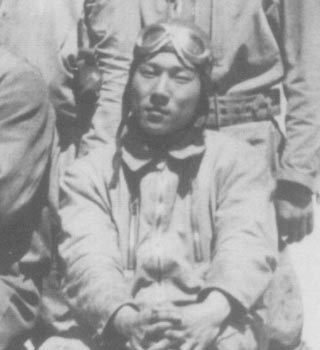Japan

Warrant Officer Tokuya Sudo
Japan

Warrant Officer Tokuya Sudo

10 February 1917 - 1 September 1939
Tokuya Sudo was born in Tokyo on 10 February 1917.
He was studying at the city’s Technical School when he decided to apply for the new Juvenile Flying Soldier programme, entering the Tokorozawa Flying School in February 1934 with the first such intake (Sho-1).
Completing fighter training at Akeno, he then joined the 4th Rentai.
With the outbreak of the China Incident in July 1937, he was posted to the 2nd Daitia’s 2nd chutai in northern China. This unit was equipped with Kawasaki Ki-10s (Type 95s).
With this unit he was to fly 80 sorties, but without meeting any opposition in the air, the unit engaging solely in ground support activities at first.
On 8 March 1938 the 2nd Daitai (Ki-10s) took off from Yuncheng for a bomber escort mission to Sian. Over Sian, eight Ki-10s of the 2nd chutai claimed three Gladiators and three Polikarpov I-15s shoot down. The three Gladiators were claimed by Captain Juichi Morimoto, Warrant Officer Umekawa and Sergeant Major Hatanaka. One of the I-15s was claimed by Lieutenant Yonesuke Fukuyama, who pursued an I-15 into a valley near Sian at low altitude and shot it down for his first victory. A second I-15 was claimed by Sergeant Sudo while flying as third pilot in First Lieutenant Iori Sakai’s section. The third I-15 was claimed by Segeant Majors Suzuki and Aito Kikuchi, who had turned back when their shotai mate, Sudo’s aircraft had developed engine trouble.
Only five Chinese aircraft were able to take off to intercept the Japanese raid on Sian airfield but none of them were shot down. However, one SB and one I-15 under repair and another I-15 were hit on the ground.
While returning from Sian, the 1st chutai encountered four Chinese I-152s. Captain Tateo Kato claimed one and First Lieutenant Kosuke Kawahara claimed one while the chutai finished off the rest.
During the day, a combined group of twelve I-15bis from the 17th and 25th PS flew from Sian to attack Fenglingdu. After dropping 25kg bombs, they ran into Japanese fighters. They lost four I-15bis when the pilots Rong Guang-Cheng and Lo Chun-Tun were shot down and killed, Liu Jin-Guang and Liu Yi-Ji were wounded and Zhou Zin-Gyan parachuted. It is possible that these are fighters that run into to the 2nd Daitai.
Kawahara’s claim made him the Japanese Army Air Force’s first ace (in the Western tradition with five victories).
On 10 April there was a second air combat in the Hsuchow area. In this Second Battle of Kuei teh, the Chinese sent 18 I-15bis from the 3rd and 4th PG to again attack Japanese Army field headquarters at the elementary school in the town of Chao Chuang.
Zhu Jia-Xun was flying one of the seven 3rd PG I-15bis led by Major Lin Tsuo. Of the remaining I-15bis five were from the 22nd PS, 4th PG and six from the 23rd PS, 4th PG. The Chinese planes bombed and strafed their target to great effect, setting many fires in the school compound and scattering many Japanese Army horses. On their return journey, the 3rd PG took the high cover position at 4,500m, 500m above the 4th PG aircraft. Near Ma Mu Chi, the lower formation of Chinese aircraft was attacked by three Ki-27s (Nakajima Type 97 monoplane fighters; this was the combat debut of this type) from the 1st chutai, 2nd Daitai, flown by Captain Tateo Kato, Warrant Officer Morita and Sergeant Major Risaburo Saito and 12 Ki-10s (Kawasaki Type 95 fighters) of the 2nd Daitai (HQ flight) led by Major Tamiya Teranishi.
The 3rd PG I-15bis were in a perfect position to "bounce" the Japanese fighters. Zhu Jia-Xun caught the Ki-27 of Sergeant Major Saito (NCO50) as it was diving on a 23rd PS I-15bis. Zhu Jia-Xun apparently hit the Japanese pilot with his fire and Saito crashed his plane into that of Lieutenant Chen Hui-Min. Chen managed to bail out with a wounded leg but Saito was killed. Afterwards, Zhu Jia-Xun was surrounded by a number of IJAAF fighters and his I-15bis was damaged. His engine cowling was shot away but Zhu Jia-Xun managed to land his I-15bis safety in a wheat field. Most of the Chinese fighters were already short of fuel when the fighting started, nevertheless, they gave a good account of themselves. In the melee, two other 4th PG I-15bis were shot down, one pilot bailed out and the other was lost. Three other 4th PG aircraft force landed due to damage and fuel starvation but they were recovered. The 3rd PG lost one I-15bis and its pilot. Two, including Zhu Jia-Xun, force-landed due to damage or fuel starvation but both aircraft were recovered. Two other 3rd PG pilots were slightly injured by Japanese gunfire but returned to base safely.
As for the IJAAF, in addition to Sergeant Major Saito, one other pilot, Lieutenant Yonesuke Fukuyama died of his wounds. Fukuyama, flying a Ki-10 and despite repeated gun stoppages, managed to claim three Chinese fighters shot down when being heavily engaged together with Sergeant Major Shimokata before being hit and severely wounded in the right arm and left leg. Fukuyama flew part of the way back to Ching Chow airfield while holding the stick with his mouth! He managed to crash-land his plane at the airfield after covering the 200-kilometre flight in 50 minutes. He was immediately removed to hospital but died of his wounds four days later. Two other damaged IJAAF fighters crash-landed back at Ching Chow airfield and two crashed landed at the battlefield. Of the latter, one of the IJAAF pilots was picked up by his wingman who landed in no-man's land between the Chinese and Japanese Armies.
Sudo from the 2nd chutai of the 2nd Daitai claimed two I-15bis in this combat while Iori Sakai from the same chutai claimed three victories. Captain Tateo Kato’s 1st chutai of the 2nd Daitai (Ki-27s) fought against eight I-15bis and Kato personally claimed two of the Chinese fighters while Warrant Officer Morita claimed two more.
According to Japanese records fifteen Japanese fighters took part in this combat over Guide claiming 24 victories from 30 encountered while losing two fighters.
On 22 May Sudo claimed a victory over Lanfeng.
By May 1938 Sudo was referred to as ”The Flower of the Juvenile Flying Soldiers”.
In August 1939, now part of the 64th Sentai (which had formed from the 2nd Daitai) he moved to Manchuria to take part in the Nomonhan Incident. The 2nd chutai flew 5,000 kilometres from southern China to the new front.
From 13 August Sergeant Major Sudo flew 21 sorties, engaging in aerial combats virtually every day.
Still flying with Lieutenant Iori Sakai, his total of claims grew rapidly.
On 27 August he took off alone to intercept a reported 75 I-16s, attacking repeatedly by diving from above and zooming back to safety each time.
Next day he wrote to his mother:
“The situation is very different from that in China, and it’s worth doing, for the enemy’s fighting tactics are different and I am also learning a lot.”In the afternoon on 1 September, 188 Soviet fighters (145 I-16s and 43 I-153s) from 22, 56 and 70 IAPs fought a reported 100-120 Ki-27s and Ki-30s in mixed groups pursuing diverse tactical objectives. The fight took place at between 3500 and 5000m and featured the stepped arrival of most participants. They fought for over an hour, with the spinning ball of fighters attracting reinforcements and shedding burning machines or those whose fuel had become critical.
By the time of his death, Sudo was credited with 3 biplane victories and a total of 10.
Claims:
| Kill no. | Date | Time | Number | Type | Result | Plane type | Serial no. | Locality | Unit |
| 1938 | |||||||||
| 1 | 08/03/38 | 1 | I-15bis (a) | Destroyed | Ki-10 | Sian area | 2nd Daitai | ||
| 2 | 10/04/38 | 1 | I-15bis (b) | Destroyed | Ki-10 | Guide | 2nd Daitai | ||
| 3 | 10/04/38 | 1 | I-15bis (b) | Destroyed | Ki-10 | Guide | 2nd Daitai | ||
| 4 | 22/05/38 | 1 | Enemy aircraft | Destroyed | Ki-27 | Lanfeng | 2nd Daitai | ||
| 1939 | |||||||||
| 10 | 01/09/39 | 14:20-15:30 | 1 | Enemy aircraft (c) | Destroyed | Ki-27 | Noguchi area | 64th Sentai |
Biplane victories: 3 destroyed.
TOTAL: 10 destroyed.
(a) It is possible that these were claimed in combat with a combined group of I-15bis from the 17th and 25th PS, which lost at least three aircraft when the pilots Song Gua-Cheng and Lo Chun-Tun were shot down, Liu Jin-Guang and Liu Yi-Ji were wounded and Zhou Zin-Gyan parachuted. 2nd Daitai claimed seven Polikarpovs and three Gladiators over Sian during a mission on this day.
(b) Claimed in combat with 18 I-15bis from 3rd PG and 22nd PS and 23rd PS of 4th PG. According to Japanese records fifteen Japanese fighters took part in this combat claiming 24 victories while losing two fighters (Sergeant Major Risaburo Saito and Lieutenant Yonesuke Fukuyama) and four crash-landed. The Chinese fighters claimed two victories while losing three aircraft and five force-landed. Two pilots were killed and two pilots wounded.
(c) In this battle the Japanese claimed 32 destroyed and 8 probables while losing four aircraft and pilots (Sudo, Captain Shuichi Anzai of the 64th Sentai, Sergeant Takayori Kodama of the 1st Sentai and First Lieutenant Yosokichi Kato of the 64th Sentai). The Soviet pilots claimed 41 victories without any losses.
Sources:
Air War Over Khalkhin Gol: The Nomonhan Incident - Vladimir R. Kotelnikov, 2010 SAM Publications, ISBN 978-1-906959-23-4
Japan Against Russia In The Sky Of Nomonhan - Dimitar Nedialkov, 2005 Propeller Publishing, Sofia, ISBN 954-9367-33-9
Japanese Army Air Force fighter units and their aces 1931-1945 - Ikuhiko Hata, Yasuho Izawa and Christopher Shores, 2002 Grub Street, London, ISBN 1-902304-89-6
Ki-27 'Nate' Aces – Nicholas Millman, 2013 Osprey Publishing, Oxford, ISBN 978-1-84908-662-2
Soviet Fighters in the sky of China, Part II - Anatolii Demin, 2000 Aviatsiia Kosmonavtika 10 (translated by George M. Mellinger)
Additional information kindly provided by Edward Chan, Raymond Cheung, Tom Chan, Börje Henningsson and Nick Millman.


